Small black flies in pots with houseplants are mostly harmless, however, their voracious larvae in the soil eat young sprouts and roots. To understand how to get rid of midges in flower pots, you need to know the lifestyle and development characteristics of the pest. The struggle for the life of green pets will not be easy, because small insects hide well and breed quickly.
Material Content:
Wound midges in flower pots: reasons
Eggs, larvae and adult insects can enter a house or apartment with contaminated soil from a garden or vegetable garden. And abundant reproduction of pests contributes to improper care of indoor flowers. Adult midges live on the surface of the soil, hide in the crevices of the windowsills, and important soil serves as a breeding ground for the development of eggs and larvae.
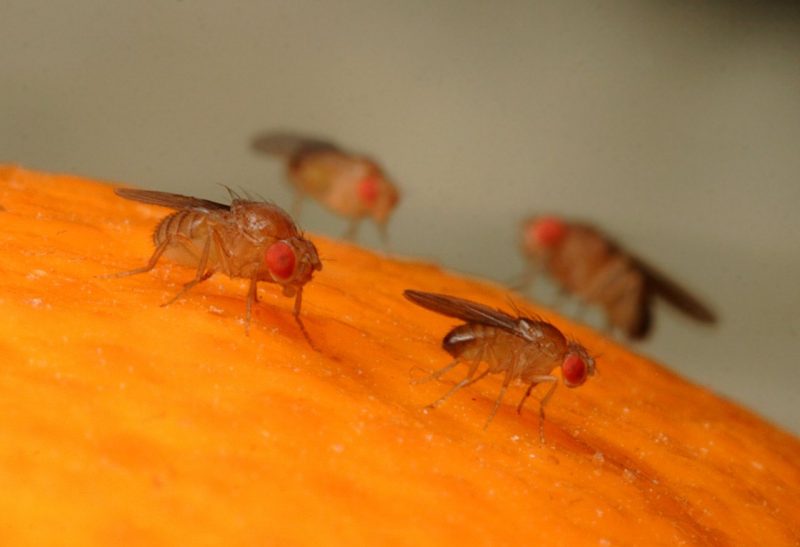
Probable causes of the appearance of small black midges:
- Penetration through windows, doors, hoods, with bouquets from the garden or forest.
- Rotting plant debris, food waste attracting insects.
- Stagnation of moisture with excessive watering and poor drainage.
- Use of infected substrates and pots.
Often midges fall into the room with potted flowers purchased at the market or from their hands. It is necessary to carefully inspect each new plant and quarantine it for 10 days to identify diseases and pests.
Types of midges on plants
Several species of insects belonging to the Scyarid family, the Diptera order, adapted to life in flower pots.

In everyday life they are called midges and flies, although these are leaf, or soil, mosquitoes:
- Sciara (Sciara);
- mushroom mosquitoes (Lycoriella);
- and bradysia (Bradysia).
The sizes of adults do not exceed 5 mm, the length of young insects is 1.5 mm. They scurry about in flower pots, fly over to window sills, window frames, shelves.
Adult midges almost do not eat. Females lay eggs on the roots of plants or on the surface of the soil. Almost transparent larvae with a black head end appear from them. First, they feed on mushrooms, algae and plant debris. Then they switch to eating young roots. A favorable environment for the development of larvae is a waterlogged substrate.
Scyarides damage young roots that absorb water with dissolved substances. As a result, plants do not receive the necessary nutrition and moisture, develop poorly and can die.
Flowers in greenhouses, greenhouses, on terraces, balconies and in rooms can be harmed by circus plants. These are representatives of the family Cicadellidae, the order of the Semi-Rugged. From the midge-sciaridae, the cicadas are distinguished by larger sizes (up to 10 mm), a body shape in the form of the Latin letter V and various colors (yellow, green, light gray).
Adult individuals and larvae suck out plant sap and inject poisonous saliva, which causes a change in the color and shape of the leaves. Cicadas feed on leaves and flowers, can fly around the room, wingless nymphs bounce high.
What plants most often bring midges?
Omnivorous larvae of sciaridae harm very many indoor flowers. The most susceptible plants are in old pots with soil that has not been updated for a long time, where rotting parts and soil algae accumulate. If the colony of midges grows, then they migrate in containers with rooted cuttings, recently planted plants that give a large amount of food - young leaves and roots.
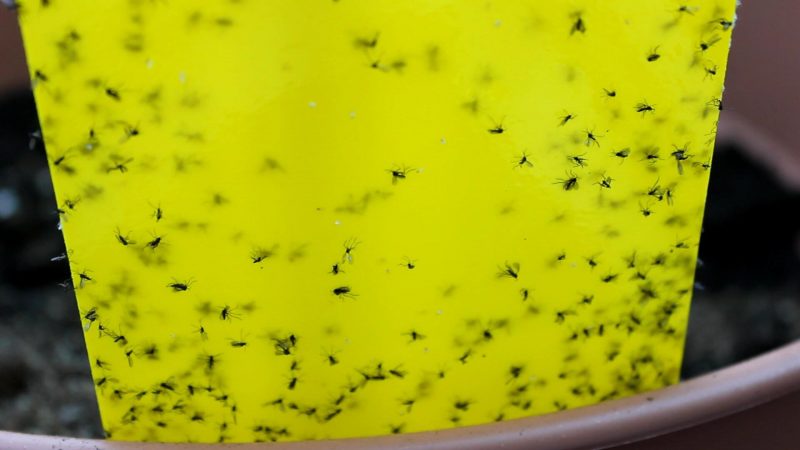
Adult mosquitoes spread fungal spores. Larvae carry viral, bacterial and fungal infections, ticks and nematodes.
Most often, scyarides are found in waterlogged substrates, in pots with weakened plants. To the greatest extent, black midge larvae harm cyclamens, violets, pelargonium, poinsettia, room chrysanthemum and hibiscus. Cicadas affect rhododendrons, potted roses, primrose.
Read also:cyclamen: home care
How to get rid of midges and their larvae in flower pots
Plants should be watered correctly, avoiding waterlogging of the substrate and stagnation of water in the pan. If midges appeared in flower pots, then most likely they laid eggs in the soil.
Folk methods
To scare away small insect pests, lemon peels, cloves of garlic, tansy twigs, wormwood, and yarrow are spread on the soil surface in pots and on window sills. Frequent spraying of indoor flowers and rinsing of pallets with infusion of tobacco leaves helps. Prepare a solution to combat midges from 20 g of raw materials and 0.5 l of water. Insist for two days, filter and add 1 liter of water.
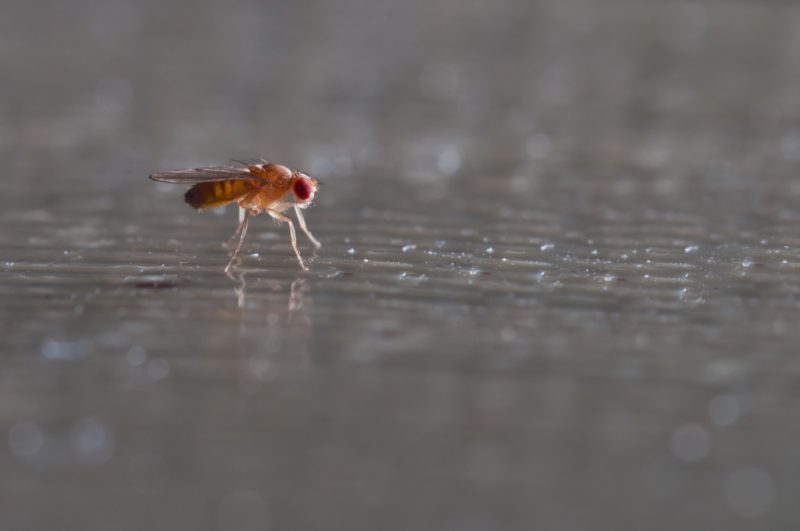
Before fighting midges in flower pots using folk remedies, it is necessary to assess the degree of soil contamination with larvae. Worms with a length of a few millimeters to 1 cm live at a depth of 1-3 cm. Folk remedies can not cope with a large number of eggs and larvae, but only temporarily scare off adult midges.
Chemicals
You can spray plants with household aerosols against flying insects Neo-Dichlorvos or Raptor. They process flower pots, shelves and window sills on which containers with plants are installed. An effective remedy for midges is the insecticidal spray of Bon Forte. A liquid preparation based on natural pyrethroids is sprayed with plants, soil and pots.
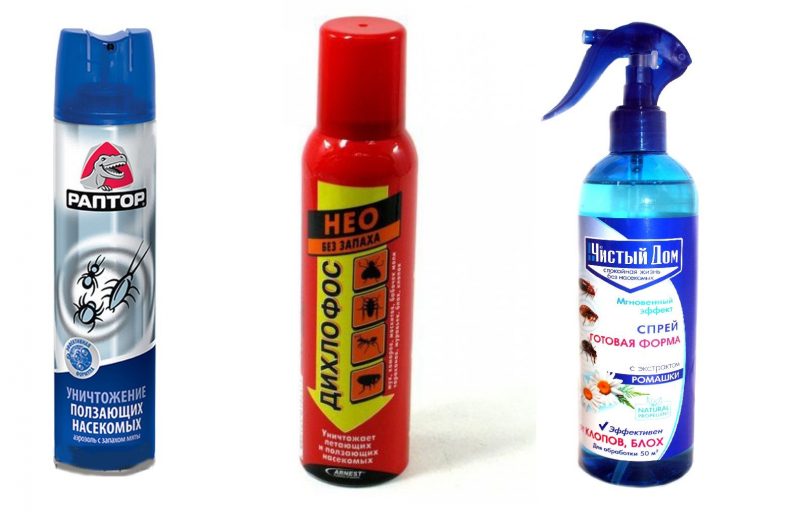
The precautions indicated on the packaging of the chemical must be observed. Processing is carried out in the absence of indoors people and pets.
To completely destroy midges in flower pots under the power of the chemical preparation "Aktara". The insecticide is used to combat larvae in the soil.For processing indoor plants, it is more convenient to use granules in a bag weighing 4 g or a suspension in ampoules (1.2 ml). With severe infection, dissolve the contents of 1 ampoule in 0.75 L or 1 g of granules in 1.25 L of water. The liquid is used for watering the soil and spraying plants.
After a single treatment, insects can reappear, since the insecticide does not destroy the eggs. Therefore, it is necessary to re-spray and water the soil with a solution of Aktara. After that, you can forget about midges for a long time.
- In addition to Aktara, the soil insecticide Bazudin is used against larvae.
- To destroy the cicadas, the Bona Forte spray is used.
- In non-residential rooms, greenhouses and greenhouses, plants are sprayed with a solution of the insecticidal drug Fufanon-Nova. Dissolve 2 ml of the drug in 1.5 l of water.
Soil replacement
Cats and larvae in flower pots do not tolerate drying of the substrate, therefore, it helps against pests and the lack of watering for some time.
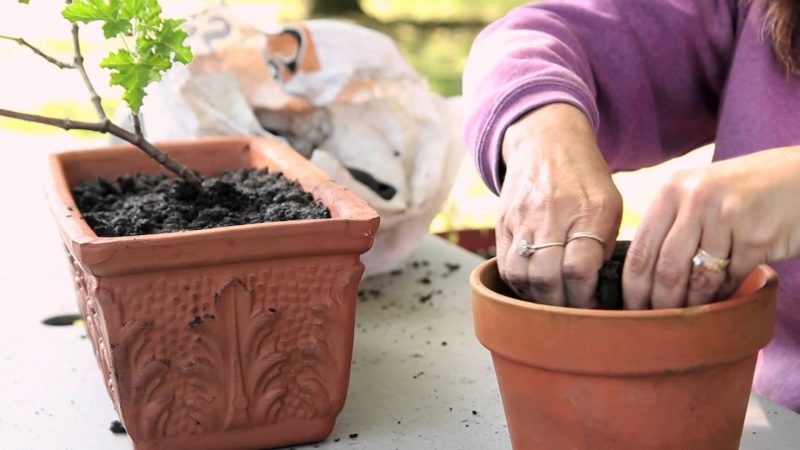
Drying the topsoil to a depth of 1 to 4 cm leads to the death of egg clutches and larvae.
If midges are wound up in a flower pot, then as a measure of control, soil removal to a depth of 2 cm is used in medium-sized pots, 3-4 cm in large flowerpots and tubs with flowers. Instead of an earthen substrate, an insulating layer is poured on the surface with a height of 1.5 - 2 cm from calcined river sand, crushed expanded clay, fine gravel. You can mix the selected material with charcoal.
After the sciarides have bred, partial replacement of the soil in the pot becomes only a temporary measure. With severe infection with larvae, it is necessary to completely change the soil. Soils with rotting plant residues are not suitable for planting and transplanting. The substrate purchased in the store is sent for several days to the freezer for disinfection. The soil from the garden is additionally calcined in the oven.
When replanting a plant:
- Remove rotten roots.
- They treat the cut points with wood ash.
- Flower pots are washed with hot water and a solution of potassium permanganate.
- At the bottom, a drainage layer of expanded clay, ceramic shards or gravel is necessarily formed.
Preventive actions
It is necessary to optimize watering so that there are no conditions for the propagation of midges in the soil of flower pots.

It is not recommended to use tea leaves, coffee grounds, milk whey, water after thawing and washing meat for top dressing.
- You should regularly inspect the substrate in a pot, a windowsill or a rack with plants.
- It is necessary to remove rotting leaves, green and white films, consisting of algae and mushrooms.
- It is advisable to wash the windowsills and shelves with a solution of soda and soap and wipe them dry.
- It is necessary to timely eliminate the sources of the spread of dampness and mold.
Puppies in flower pots cause great damage to indoor plants. Proper care and disinfection of the substrate will help to avoid the rapid multiplication of scyarides. Various methods are used to get rid of midges: replacing the topsoil, replanting flowers, and treating with folk remedies. The most radical way is spraying with insecticidal drugs.












